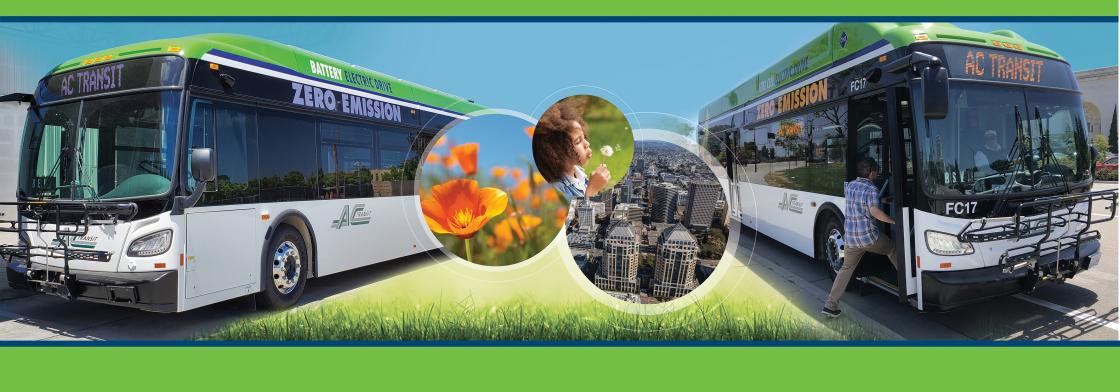Environment

In the Bay Area, more air pollution comes from motor vehicles than from any other source. So, every time someone takes public transit instead of a car, we can all breathe a little easier. By carrying over 51,760,000 riders per year, AC Transit is doing its part to keep thousands of cars off the roads and their resulting pollution out of the air. Central to our clean air initiatives is forward-thinking service planning (that increases ridership while decreasing our environmental footprint) and innovative technologies that directly address some of the environmental challenges facing our service area.
AC Transit is investing in our planet and the future by leading the fight against climate change. Since 1999, AC Transit has been committed to exploring conversion to zero emission technologies—first with hydrogen and now battery-powered buses. AC Transit is moving from vision to reality and is actively converting one of the largest bus fleets in California to 100% clean fuels. By the end of 2023, 10% of AC Transit’s fleet will be zero emission clean air buses. By 2040, 100% of AC Transit’s fleet will be zero emission buses. Learn how we are moving to a 100% zero emission fleet. This transition gets us closer to achieving climate change goals while improving the air you and your family breathe every day.
By choosing AC Transit, YOU are helping to revitalize life and our communities by investing in the planet. Follow along on social media and sign up for our zero emission email list.
Ask AC Transit: What’s the benefit of zero emission buses?
AC Transit’s first zero emission bus (ZEB) went into service in 2002, and we’ve come a long way since then. We’ve deployed both hydrogen fuel cell and battery electric buses, even launching a groundbreaking side-by-side analysis [link to ZETBTA] of bus technologies to see which works best for our service. Converting our fleet of more than 600 buses is no easy feat. So why is AC Transit going 100% zero emission? We’re glad you asked!
Zero Emission Benefits
- Jobs: ZEBs bring good paying green jobs to our community
- Better Ride: Compared to diesel technology, driving ZEBs reduces fatigue because of reduced noise and vibration. It’s smoother for riders too!
- Quieter: ZEBs are quiet and reduce ambient noise while traveling though the East Bay’s residential neighborhoods
- Cleaner: ZEBs are proven to be an effective way for communities to reduce their carbon footprint. ZEB’s have no tailpipe emissions—adios diesel exhaust gases!
- Healthier: ZEBs bring cleaner air to our communities, reducing particulate matter concentrations that can result in increased asthma rates and other negative health impacts

Green Jobs
Kyin Kyu has been a journey level mechanic for the past eight years and has specialized in zero emission buses, including hybrids, fuel cell, and battery electric buses, for the past two years. Our zero emission program continues to create green jobs like this. From training to technologies, change is consistent in the zero emission program, and Kyin has experienced it all.

Let’s go green together. Take transit!
Did you know that one bus has the potential to take up to 30 cars off the road?
In California, the transportation sector accounts for about 50 percent of the state’s greenhouse gas emissions. Reducing the number of vehicles on the road is critical to achieving climate change goals and clean air standards.
Everyone knows that taking transit is good for the environment. Be part of the solution—a typical trip on public transit emits 55% fewer greenhouse gas emissions than driving alone.
Greening Our Community
In the Bay Area, more air pollution comes from motor vehicles than from any other source. So, every time someone takes public transit instead of a car, we can all breathe a little easier. By carrying over 51,760,000 riders per year, AC Transit is doing its part to keep thousands of cars off the roads and their resulting pollution out of the air. Central to our clean air initiatives is forward-thinking service planning (that increases ridership while decreasing our environmental footprint) and innovative technologies that directly address some of the environmental challenges facing our service area.
Reducing Vehicle Emissions
AC Transit has embraced the exhaust emission standards set by the California Air Resources Board (CARB) for more than 15 years, launching its first hydrogen fuel cell pilot program into service in 2002. Since then, our transit district has adopted operational practices and programs that proudly exceed state environmental standards—including building one of the most comprehensive hydrogen fuel cell programs in the United States. As funding allows, AC Transit continues to purchase and integrate new zero emission buses (ZEBs) into our fleet—prioritizing their deployment to several disadvantaged communities through our Clean Corridors Plan. AC Transit is currently conducting a side-by-side analysis of buses using fuel cell versus battery electric technologies to determine which works best for our service. Learn more about our full Zero Emissions Bus Rollout Plan here.
Producing Green Energy Through Solar
AC Transit has 1,427 kW (DC) of installed solar in 7,032 panels located on an elevated trellis system in Hayward and on the rooftops of its CMF, Oakland and Hayward facilities. These solar systems deliver approximately 2,226 MWh of power per year—a significant portion of what is required to operate each facility. This amounts to an approximate carbon dioxide emissions savings of 1,535 metric tons per year.
On the Horizon
The California Air Resources Board (CARB) has recently passed an aggressive Innovative Clean Transit Regulation, requiring all transit agencies to transition their fleets to zero-emission technologies by 2040. AC Transit is leading the way to this zero-emission future by its integration of battery-electric technology into our fleet. These have joined our hydrogen fuel cell buses to expand our clean vehicle infrastructure and provide valuable data comparing battery-electric-bus to fuel cell-electric-bus technology in order to determine what works best for our service.
